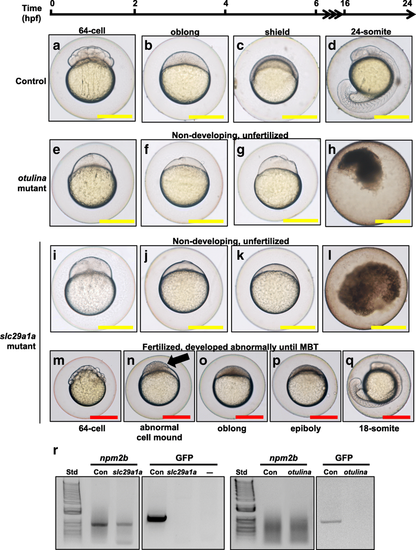- Title
-
What makes a bad egg? Egg transcriptome reveals dysregulation of translational machinery and novel fertility genes important for fertilization
- Authors
- Cheung, C.T., Nguyen, T.V., Le Cam, A., Patinote, A., Journot, L., Reynes, C., Bobe, J.
- Source
- Full text @ BMC Genomics

ZFIN is incorporating published figure images and captions as part of an ongoing project. Figures from some publications have not yet been curated, or are not available for display because of copyright restrictions. EXPRESSION / LABELING:
|

ZFIN is incorporating published figure images and captions as part of an ongoing project. Figures from some publications have not yet been curated, or are not available for display because of copyright restrictions. |
|
Representative images showing the development between 0 and 24 h post-fertilization (hpf) of F1 embryos from wildtype control (a-d), otulina-deficient (e-h), and slc29a1a-deficient (i-q) females. In the control eggs, the embryos were at 64-cell (A), oblong (b), shield (c), and 24-somite (d) stages according to Kimmel et al. [56]. Eggs from otulina and slc29a1a mutant females were non-developing and did not under any cell division (E-L). Some eggs from two slc29a1a mutant females were developing abnormally (M-Q). (a, e, i, m) = images taken at 2 hpf; (b, f, j, n) = images taken at 4 hpf; (c, g, k, o) = images taken at 6 hpf; (P) = image taken at 8 hpf; (d, h, l, q) = images taken at 24 hpf. The arrow demonstrates a partially cellularized blastodisc that was sitting atop an enlarged syncytium. Scale bars denote 500 μm. R: PCR genotyping for nucleoplasmin 2b (npm2b) and vasa:eGFP in spawned eggs from WT, otulina-, and slc29a1a-mutant females crossed with vasa:eGFP males to detect fertilization of the eggs. Std = 1 kb ladder; Con = WT female crossed with vasa:eGFP male
PHENOTYPE:
|

ZFIN is incorporating published figure images and captions as part of an ongoing project. Figures from some publications have not yet been curated, or are not available for display because of copyright restrictions. |

